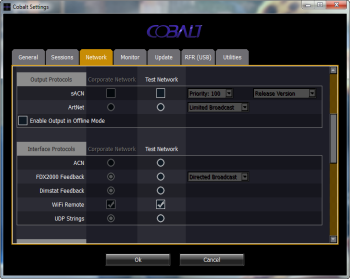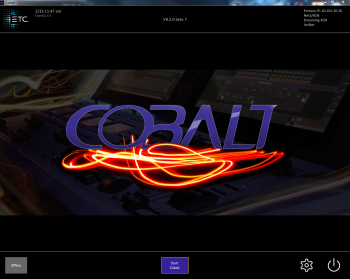Protocols
The protocol you use depends on the lighting devices you wish to control and the intermediate converter you may need to get data to those lighting devices. For example, if you want to control an ETC Sensor3 dimmer rack, you can connect the rack and the computer to an Ethernet network and communicate directly to the rack using the sACN protocol. No intermediate converter is required if all your lighting devices can communicate over Ethernet directly.
If you are connecting to a DMX based system, an intermediate converter is required to translate an Ethernet lighting protocol to DMX.
The Ethernet lighting protocol settings are found in the System Settings application, on the network tab, accessible from the main Cobalt welcome screen.

Protocols are assigned to the Ethernet port. Scroll down on the Network tab to find the Output Protocols and their settings:
- ACN – enable this if you are using ETC Net3 DMX/ RDM Gateways and you want to use the RDM protocol, or if you are using ETC Net3 I/O or Show Control Gateways with your system.
- sACN – enable this if you want to use the sACN protocol to send levels to devices or if you are using an ETC Net3 DMX/RDM Gateway or other sACN converter to send levels.
- ArtNet – enable this if you are using ArtNet or an ArtNet converter to send levels to devices. Please note the Address options and adjust this setting if necessary based on the ArtNet devices you are controlling. See the user documentation of those devices for more information.
Your selected network connection and Ethernet lighting protocol(s) are displayed in the upper right corner of the welcome screen when you start the Cobalt application.

Using Lighting Protocol Converters
If you have lighting devices that require DMX protocol, you will need to use an intermediate converter to take either an Ethernet-based lighting protocol that Cobalt ETCnomad outputs or USB output and turn it into DMX protocol for your devices. There are a number of options available to you:
ETC Response or DMX/RDM Gateways - sACN Protocol
Available in one-port, two-port and four-port sizes, this is the most configurable option for use with Cobalt ETCnomad. These Gateways also support the RDM protocol for remote addressing, monitoring and setup of RDM-capable devices. You can find out more about the Response and Net3 Gateways at our web site etcconnect.com/networking. If you choose to use these Gateways, Net3 Concert software available at etcconnect.com/networking can be used to configure them for use on your network.
Note: To use Response or Net3 Gateways it may be necessary to enable Network Services and the Address Service (DHCP). Please check with the administrator of the network you are connecting to before enabling the DHCP service.
ArtNet and Other sACN Protocol Converters
A number of companies offer converters that take in the ArtNet or sACN protocol and send DMX. If you choose to use a converter made by others, please consult the user documentation of the converter for instructions on setup and use.
What about USB-DMX Converters?
Cobalt ETCnomad supports ETC Gadget USB-DMX converters for additional universes of output. Each Local DMX universe may be setup by navigating to Browser>General Settings>DMX Settings from within the Cobalt show file. The DMX Universe, Speed, and RDM may adjusted there.
Tip: Multiple Gadgets (up to four DMX ports) can be used on a single network.
Note: A Mac ETCnomad system will only support USB connections to Gadget, Eos/ Cobalt Programming wings and a single Cobalt Motor Fader wing. It will NOT support other USB devices such as Universal fader wings.There are no limitations on Ethernet-connected devices.